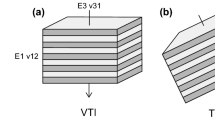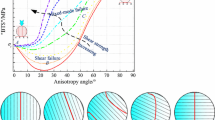Abstract
The construction of a shale rock physics model and the selection of an appropriate brittleness index (BI) are two significant steps that can influence the accuracy of brittleness prediction. On one hand, the existing models of kerogen-rich shale are controversial, so a reasonable rock physics model needs to be built. On the other hand, several types of equations already exist for predicting the BI whose feasibility needs to be carefully considered. This study constructed a kerogen-rich rock physics model by performing the selfconsistent approximation and the differential effective medium theory to model intercoupled clay and kerogen mixtures. The feasibility of our model was confirmed by comparison with classical models, showing better accuracy. Templates were constructed based on our model to link physical properties and the BI. Different equations for the BI had different sensitivities, making them suitable for different types of formations. Equations based on Young’s Modulus were sensitive to variations in lithology, while those using Lame’s Coefficients were sensitive to porosity and pore fluids. Physical information must be considered to improve brittleness prediction.
Similar content being viewed by others
References
Bandyo padhyay, K., 2009, Seismic anisotropy: Geological causes and its implications to reservoir geophysics: PhD Thesis, Stanford University.
Ba, J., Carcione, J. M., and Nie, J. X., 2011, Biot-Rayleigh theory of wave propagation in double-porosity media: Journal of Geophysical Research Solid Earth, 116(B6), B06202.
Ba, J., Cao, H., Yao, F. C., Nie, J. X., and Yang, H. Z., 2008, Double-porosity rock model and squirt flow in the laboratory frequency band: Applied Geophysics, 5(4), 261–276.
Backus, G. E., 1962, Long-wave elastic anisotropy produced by horizontal layering: Jounal of Geophysical Research, 67(11), 4427–4440.
Brown, R., and Korringa, J., 1975, On the dependence of the elastic properties of a porous rock on the compressibility of the pore fluid: Geophysics, 40(4), 608–616.
Chen, J. J., Zhang, G. Z., Chen H. Z., and Yin, X. Y., 2014, The Construction of Shale Rock Physics Effective Model and Prediction of Rock Brittleness: 84th Annual International Meeting, SEG, Expanded Abstracts, 2861–2865.
Goodway, B., Perez, M., and Varsek, J., 2010, Seismic petrophysics and isotropic-anisotropic AVO methods for unconventional gas exploration: Leading Edge, 29(12), 1500–1508.
Goodway, B., Chen, T., and Downton, J., 1999, Improved AVO fluid detection and lithology discrimination using Lamé petrophysical parameters; “λρ”,“µρ”, &“λ/µ fluid stack”, from P and S inversions: 69th Annual International Meeting, SEG, Expanded Abstracts, 16(1), 2067.
Guo, Z., and Li, X. Y., 2015, Rock physics model-based prediction of shear wave velocity in the Barnett Shale formation: Journal of Geophysics & Engineering, 12(3).
Guo, Z., Chapman, M., and Li, X. Y., 2012a, A shale rock physics model and its application in the prediction of brittleness index, mineralogy, and porosity of the Barnet Shale: 82th Annual International Meeting, SEG, Expanded Abstracts, 1–5.
Guo, Z., Chapman, M., and Li, X. Y., 2012b, Exploring the effect of fractures and microstructure on brittleness index in the Barnett Shale: 82th Annual International Meeting, SEG, Expanded Abstracts, 1–5.
Hashin, Z., and Shtrikman, S., 1963, A variational approach to the elastic behavior of multiphase materials: Mech Phys Solids, 11, 127–140.
Hornby, B., Schwartz, L., and Hundson, J., 1994, Anisotropic effective-medium modeling of the elastic properties of shales: Geophysics, 59, 1570–83.
Huang, X. R., Huang, J. P., Li, Z. C., et al., 2015, Brittleness index and seismic rock physics model for anisotropic tight-oil sandstone reservoirs: Applied Geophysics, 12(1), 11–22.
Johansen, T. A., Ruud, B. O., and Jakobsen, M., 2004, Effect of grain scale alignment on seismic anisotropy and reflectivity of shales: Geophysical Prospecting, 52(2), 133–149.
Qian, K., Zhang, F., Li, X. Y., et al., 2014, A Rock Physics Model for Estimating Elastic Properties of Organic Shales: 76th EAGE Conference & Exhibition Extended Abstract. Th D203 03.
Liu, Z. and Sun, Z., 2015, New brittleness index Brittleness Indexes and their application in shale/clay gas reservoir prediction: Petroleum Exploration and Development(in Chinese), 117–124.
Mavko, G., Mukerji, T., and Dvorkin, J., 2009, The rock physics handbook: Tools for seismic analysis of porous media. Cambridge University Press, England.
Rickman, R., Mullen, M. J., Petre, J. E., et al., 2008, A practical use of shale petrophysics for stimulation design optimization: All shale plays are not clones of the Barnett Shale: Annual Technical Conference and Exhibition. Society of Petroleum Engineers, SPE 115258.
Sayers, C. M., 1994, The elastic anisotropy of shales: Journal of Geophysical Research Atmospheres, 99, 767–774.
Sayers, C. M., 2005, Seismic anisotropy of shales: Geophysical Prospecting, 53(5), 667–676.
Sayers, C. M., 2013, The effect of kerogen on the elastic anisotropy of organic-rich shales: Geophysics., 78(78), 65–74.
Sun, C. Y., 2007, Theory and Methods of seismic Waves. China University of Petroleum of Press, Dong Ying.
Sondergeld, C. H., and Rai, C. S., 2011, Elastic anisotropy of shales: The Leading Edge., 30(3), 324–331.
Vanorio, T., Mukerji, T., and Mavko, G., 2008, Emerging methodologies to characterize the rock physics properties of organic-rich shales: The Leading Edge: 27(6), 780–787.
Vernik, L., and Nur, A., 1992, Petrophysical analysis of the Cajon Pass Scientific Well: Implications for fluid flow and seismic studies in the continental crust: Journal of Geophysical Research Atmospheres, 97(B4), 5121–5134.
Vernik, L., and Liu, X., 1997, Velocity anisotropy in shales: A petrophysical study. Geophysics, 62(2), 521–532.
Vernik, L., and Landis, C., 1996, Elastic anisotropy of source rocks: Implications for hydrocarbon generation and primary migration: AAPG Bulletin, 80(4), 531–544.
Wu, X., Chapman, M., Li, X. Y., et al., 2012, Anisotropic elastic modelling for organic shales: 74th EAGE Conference and Exhibition.
Xu, S., and Payne, M. A., 2009, Modeling elastic properties in carbonate rocks: The Leading Edge, 28(1), 66–74.
Zhu, Y., Xu, S., Payne, M., et al., 2012, Improved rockphysics model for shale gas reservoirs: 82th Annual International Meeting, SEG, Expanded Abstracts, 1–5.
Author information
Authors and Affiliations
Corresponding author
Additional information
This study is financially supported by the NSFC and Sinopec Joint Key Project (No. U1663207), National Science and Technology Major Project (No. 2017ZX05049-002), and National 973 Program (No. 2014CB239104).
Qian Ke-Ran is an engineer and a post-doctoral fellow from Petroleum Exploration and Production Research Institute of Sinopec. He received his Bachelor’s degree from Yangtze University (2010), Master’s degree from University of Edinburgh (2011), PhD degree from China University of Petroleum (Beijing) (2016). Currently, he works in Sinopec exploration and Development Research Institute. His research interests mainly focus on anisotropic rock physics modeling and sweet spot prediction of unconventional reservoirs.
Rights and permissions
About this article
Cite this article
Qian, KR., He, ZL., Chen, YQ. et al. Prediction of brittleness based on anisotropic rock physics model for kerogen-rich shale. Appl. Geophys. 14, 463–479 (2017). https://doi.org/10.1007/s11770-017-0640-y
Received:
Revised:
Published:
Issue Date:
DOI: https://doi.org/10.1007/s11770-017-0640-y




